steps
schoolwork
The art of collaboration was first taught to me by my students at a school for the learning disabled. So directly did their lessons lead to the later Ghostcatching work with Shelley Eshkar and Bill T. Jones that I shouldn’t skip over this unlikely origin. Not only did these children teach me the power arising from unusual collaborations, but they also helped me discover two ideas – drawing as performance and mental space. These ideas continue to guide my work with others.
In 1986, when I was first given a classroom of my own, I had a dozen twelve-year-olds who, at every break in their daily schedule, would start scribbling intensely on whatever scraps of paper were at hand. At first I dismissed this activity as mere doodling, and the drawings would wind up in crumples at the back of their desks. But one day their excitement over one of the sketches attracted my attention, which sharpened when I found I’d been made a figure in the drawing. There I was: a passive, bespectacled figure possibly a prisoner – behind a little window at the top of a tower, which surveyed a battle raging across the expanse of paper below.
Afterwards, as I began observing children drawing more closely, I realized that their artwork was less compelling as product than as performance. Like everyone else, I was used to seeing their art stapled to bulletin boards or stuck with magnets to refrigerator doors, but now I understood that the finished drawing was merely the last frame in the movie of its enactment.
Watch children drawing and you’ll see this for yourself: they are performing, though mostly for themselves. Their strokes are dramatic gestures tied to dialogue, narration, and song (the soundtrack may be sub-vocal, but notice the moving lips). As the drawn improvisation develops, new lines are scribbled in, and old ones erased or crossed out, one scene following another.
This art activity is akin to filmmaking, for look how their shots keep changing. They rest their chin on the page for an intense close-up, then sweep their head back up into the air, pushing the paper away to behold it at arm’s length in long shot.
Such performances, I knew, were largely private and enclosed; but I wondered how to open them up for the audience they deserved. The answer was to restore their drawings to their original and proper dimension: time. That is, to animate them. As a practical matter, however, we’d have been stuck if the invention (or at least popularization) of computer multimedia had not occurred just then. All of a sudden, around ‘85 or ‘86, even amateurs like my students and myself were able to digitize the essential elements – scan the drawings, sample the voices – and to animate the two together.
So we stretched out these drawings in time, and a curious thing happened. We noticed that as we painstakingly reconstructed even the fastest and most impulsive drawings, they kept deepening and unfolding in ways none of us expected. This was as much a revelation to me as to my students, though in retrospect it seems obvious: magnify and decelerate anything, and a world of wonders will emerge. What emerged here was something like a cinematic record of each child’s mind in action.
If children’s drawings mirrored the space of their imaginings, even more remarkable was that certain of my older students became conscious of this fact. This gave rise to an intense series of multimedia collaborations that delved into the idea of mental spaces.
The longest and most elaborate of these was with Mark. He was eleven when he started and thirteen when he finished an interactive depiction of his own mind. This took you into a model of his consciousness, which he drew (first by hand and later on the computer) as a series of receding corridors.
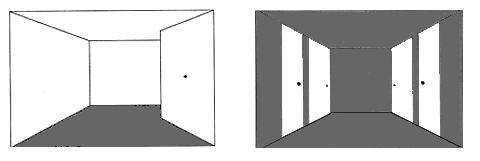
There were doors you could enter and stairs you could descend, and as you ventured farther into this world, you found it becoming ever more complex and fragmented and self-referential. You realized you were on a quest, a pursuit of an extraordinary intelligence that kept blocking and short-circuiting itself until the final moment of breakthrough to self-understanding.
robert wilson
Theater artist Robert Wilson had also collaborated early on with special education students, and his earliest major productions had been created first with a deaf-mute child and later with an autistic one. I’d last seen his extravagant theater pieces as a college student in the mid-70s, but after I left teaching almost twenty years later, his foundation engaged me to investigate his archive, where I soon found much of interest.
Most interesting was that Wilson always began his work with drawing. He constructed his plays by sketching their storyboards rather than by writing their scripts. To have Bob describe a play was to have him draw it, and it was obvious that I could explore his work in the same way I’d explored my students’ creations.
As often as Bob drew within the neat frames of a storyboard, however, he drew over a single composition in successive layers, elaborating and modifying a scene over time by sketching, smudging, and erasing it. It was only after I had filmed him making such drawings that I was able to have the scanned drawings digitally restored to a time sequence. It was a monumental labor. With the help of several students from Cooper Union, I managed to take the drawings back not only to their original layers but even to their original strokes. After that, I could replay the execution of the drawings in time, synced both to Wilson’s voice and to archive fragments rescued from reel-to-reel videotape whose magnetic record had often decayed just short of extinction.
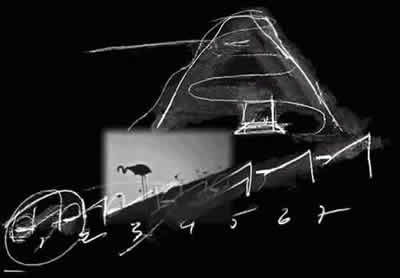
Superimposed over the drawing, these fragments would fade in and out like ghosts conjured up briefly by their drawn likenesses. This performance of recollecting became its own theater of memory, shadowing performances long vanished from the stage.
gestural 3d
All of this work with drawing had opened up one of its concealed dimensions – time – but there was still another to be puzzled over: space. Might it be possible to enter a drawing as if entering a 3D space? to move around inside it as if within the mind of its creator? I gave this idea a name – “hand-drawn space”- and wondered how it might possibly work.
At the time, in the early 90s, the field of computer graphics was largely devoted to a kind of optical realism long discarded in 20th century visual art. The more “realistic” the 3D rendering, the more synthetic its feeling. With its too-logical forms and lights and reflections, it left no room to think or to breathe.Hand-drawn space seemed a better approach, but since I had neither the skill nor the knowledge to evaluate it, I looked for others who did.
Susan Amkraut and Michael Girard – extraordinary computer programmers – were the first to understand these speculations. They had spent years together, writing algorithms to generate 3D space and the movement of figures within it. Meeting them was a turning-point: they immediately grasped what a hand-drawn space might be, put to rest my fears about its viability, and explained how to go about prototyping it.
For the prototype I chose a Wilson notebook drawing whose depicted stage space could be broken down into a simple geometry of planes and cubes: the large cube of the room itself, and the smaller cubes of platform, table, chairs, and shelf. A gifted designer from Cooper Union, Nam Szeto, then modeled this geometry in a 3D program and texture-mapped scanned areas of the drawing onto corresponding spaces of the model.
When you moved a camera through this space, the texture-mapped drawing would adjust to your angle. Past a certain point, this adjustment would read as pixelated distortion, but still the test gave you the crude but powerful sensation of entering the picture.

Good enough as proof of concept, though it was two years before Shelley Eshkar took over work on the problem and arrived at its complete solution.
dance
In the meantime, dance started to enter the picture, with several things ushering it in. The first of these was a new section of the Wilson project that explored his principles of movement on the stage. For that, I’d arranged to videotape him demonstrating his movements in an “ulti-matte” (or “blue-screen”) process that allowed the filmed figure to be detached from its background. This is the same method that lets weathermen on TV stand and gesticulate in front of animated weather maps. I had planned something subtler but similar for Wilson, but when I saw his isolated body moving across an erased background, I left it alone.
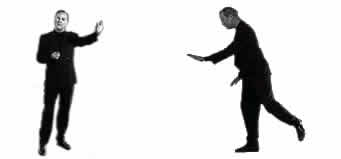
The first of these was a new section of the Wilson project that explored his principles of movement on the stage. For that, I’d arranged to videotape him demonstrating his movements in an “ulti-matte” (or “blue-screen”) process that allowed the filmed figure to be detached from its background. This is the same method that lets weathermen on TV stand and gesticulate in front of animated weather maps. I had planned something subtler but similar for Wilson, but when I saw his isolated body moving across an erased background, I left it alone. His movements had become calligraphic, as if he was making marks on the screen with his whole body, spelling out messages in an unfamiliar alphabet of motion and pose.
Soon afterwards, ballet came into view in the person of William Forsythe, the American expatriate who had revolutionized classical dance as director of the Frankfurt Ballet. He had seen part of the Wilson project and was interested in creating a multimedia work to teach his methods to new members of his company. At our first meeting in Frankfurt, Billy tried to convey to me how he derived unexpected kinds of movement from the vocabulary of the classic ballet. As he described his methods, he began drawing imaginary shapes in the air, using all the parts of his body – not only his feet and hands, elbows and knees, but also his skull, shoulders, butt, and even his ears and chin. He talked and moved rapidly, building up a complicated and invisible geometry of dance that I had no ability to visualize or follow. As a non-dancer, I had little awareness of the body’s kinesphere – the total volume of a body’s potential movement. This was an awareness that Forsythe and his dancers had developed to an extraordinarily acute degree.
Later I suggested to Billy that he use computer animation to make his demonstrations visible. By superimposing computer renderings of the drawn lines and shapes over video recordings of him performing them, he could show his mental visualizations as clearly as his physical movements. This is exactly what he proceeded to do, working with Chris Ziegler, Volker Kuchelmeister, and others at the Center for Art and Media Technology (“ZKM”) in Karlsruhe. The resulting installation, Improvisation Technologies (19–), is an eye-opening exposition of his radical choreography. How uncanny it was to watch Billy trace a line in the air, spin away to perform some other movement, then lock into his original pose and pick up the ends of the imaginary line precisely where he had left them.
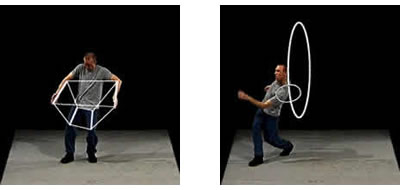
Billy trains his dancers to picture the trajectories and trails either left behind or implied by their movements in space, and he insists that they learn how to manipulate and transform that invisible geometry. He propels his choreography in this fashion, with spatial transformations the key to his thinking. His implicit lesson to me was to focus on the space created by the moving body rather than on the space merely occupied by it.
Back in New York, the next step was to wonder whether a hand-drawn space could be spun out of dance movement rather than stage architecture. There were many reasons to believe it could, all in the form of new and old collaborators.
Merce Cunningham is the grand master of modern dance, famous among many other things for his open explorations of new technology – from film to video to computers. When he looked over the hand-drawn test we had made from Wilson’s sketch, he played it through several times, nodded his head, and paused. “Yes, yes,” he said, pointing to a small figure lightly sketched in the background, “but can you make that figure move?”
A good question, to which Michael Girard, Susan Amkraut, and Shelley Eshkar had already given me the answer: “Yes.” So, simple as that, Merce agreed to make a piece with us, a project we were already calling “Hand-drawn Spaces.”
A dance conceived purely for the computer was what we were after, though the movements of this dance were to be as true to life as possible, with no computerized moves to violate the constraints of the human anatomy or the laws of the physical world. The dance was to create a hand-drawn space purely from the movements of digitally recorded dancers, re-sequenced and re-combined by Merce with unprecedented precision. It was to put you right into Merce’s remarkable mind, rendering a mental rather than a pseudo-physical stage-space.
character studio
Susan Amkraut and Michael Girard had quietly invented the software needed to do this. Having worked for years on the simulation and generation of animated figures on the computer, they had gone beyond what moving bodies looked like (the focus of traditional animators) to how they actually operated (the province of robotics, whose lessons they studied deeply). They came to understand the rhythms and patterns of gait-shifting across a variety of possible bodies (from the human biped to the insect centipede), re-creating how a walk turns into a run or a canter into a gallop. They learned how to depict the intricate play of forces on the body, such as acceleration and gravity. They figured out how to simulate the complex dependencies between all parts of the anatomy, calculating multiple joint rotations and limb extensions moving simultaneously at different rates and intensities. They had written software to make their own computer artworks, such as Eurhythmy (1990), Menagerie (1993), and Brouhaha (1994) – which were to play a governing role in shaping the Ghostcatching finale. Now they were expanding this code into a general-purpose human animation tool, eventually called Character Studio.
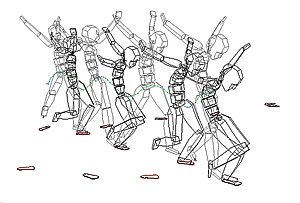
For this program, Michael had had a key insight. He had been searching for a way to let animators and choreographers work more simply with moving figures. One day it struck him that footsteps were the answer. What better or more intuitive device could there be? He saw that you could start your animation by specifying the footsteps – a set of patterns in time and space – and build up from there, adding upper body motions to the sequence. Bending or stretching a “footpath” (as Merce would come to call it) would alter the movement, as the simulated body recalculated its center of gravity and adjusted its balance.
Susan and Michael went on to endow their software with the ability to extract the motion of one figure and transpose it to another. Unwittingly, they helped spawn the uncanny “Dancing Baby” animation, in which an infant body performs an adult dance. They watched in amazement as this offbeat clip hit a popular nerve, flooding the Internet and beyond.
Together they realized that a pitfall of their software was that its figures often moved too well. Lost were the little accidents and secondary motions that give actual movements their individual and indeed unrepeatable character. But they imagined that if they could sample real movement as the raw data upon which their program would operate, the best of both worlds might come together. So they turned their attention to motion-capture, a technology that had advanced steadily from its distant origins in the 19th century experiments of Jules-Etienne Marey.
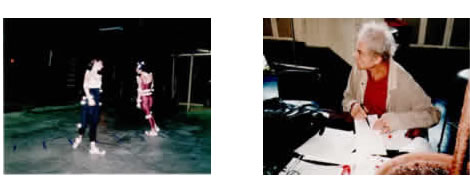
Optical motion-capture tracks reflective sensors attached to a moving body. Cameras surrounding the performer record the position and rotation of each of these sensors in time and space, then feed these streams of information to a central workstation for reconciliation and consolidation into a single data file. Motion-capture files can then drive the movement of a simulated figure on the computer, where they can be merged, connected, re-sequenced, and mapped to other anatomies in Character Studio, giving the choreographer or animator a new set of possibilities.
“The Disney and Warner Brothers cartoonists exaggerated movement in order to convey meaning,” Michael once remarked. “They perfected a kind of moving caricature. By contrast, what we’ve sought in computer animation is to open the door to a new type of animation, one in which we can focus on the subtleties and micro-structure of motion.” This ambition matches that of most choreographers, who have little interest in the simplified exaggerations of pantomime.
It was a choreographer’s perspective that Susan and Michael wanted to approximate as they figured out a new method of working with multiple movement sequences.
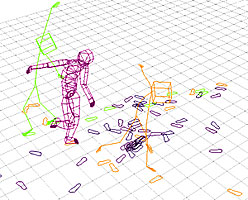
The “Motion Flow Editor” they programmed during the Hand-drawn Spaces project let Merce connect his many motion-captured sequences in any order. Most astonishingly, the program interpolated the proper gait-shift transitions from one motion to another, so that the shifts from a run to a jump to a walk, for example, would occur smoothly over a specified range of frames rather than in an abrupt cut. It also allowed Merce to determine whether a transition between two phrases would match up the positions of the right or left feet, for example, or if it was to occur in mid-step. Now the software had the breadth and the precision required by Merce to choreograph a complex dance. But the question remained how to create hand-drawn figures to embody that dance.
hand-drawn bodies
“Motions in a void needing bodies – and not just any motions! This was the challenge,” Shelley Eshkar later recalled.
“When learning to draw from life, you make thousands of gesture drawings. Your eyes glued to the moving life model, you trust your hand to keep in time. Look at the page too long and it’s gone.
“Of course these sketches couldn’t actually reconstruct complex motion. They were more about empathy. In drawing class, when everyone’s work was tacked to the wall, you could sense their eye’s frantic path along that moving body, contours weaving inside and out. Other lines, more abstract, were written in pure empathy, identifying with the tension, rhythm, and intent of that body.
“When attempting the virtual dancers, I found the lessons of physical drawing often didn’t work – because the lines that once implied movement were now actually moving. All the markings I used to convey motion or energy on paper now looked mannered. I had to pare down my vocabulary of marks to those that seemed internally motivated by the dancing – some lines felt true, others didn’t.
“Each hand-drawn dancer was to be a lens for seeing the body in motion differently – to give a sense of bilateral symmetry, or of wingspan, or of the torque of a strong center.”
Shelley had begun collaborating with me at Riverbed, our studio, two years before the Cunningham project. He had grown up with computers and could get inside the machine in a way I could only marvel at. He seemed to inhabit the visual interface as if plugged right into it, and he was blazingly fast. But he also had a wonderful eye. He had gone to art school at Cooper Union where he had studied drawing, photography, sculpture, and computer graphics. Now as he began working on the problems of hand-drawn figures, he found all these bodies of knowledge converging.
Shelley had to model every stroke of a hand-drawn figure as a 3D object in the computer. In other words, he executed the “drawings” entirely on the machine, in a process more like building wire sculpture than like putting pencil to paper. He worked in pure geometry – points and lines and angles in space – and his basic tool was the spline.
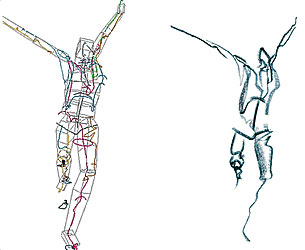
Splines are curves described mathematically by connecting a series of points. The basic character of that curve – tight or loose, smooth or rough – is tremendously versatile. Splines were the foundation for the more sculptural objects that made up the hand-drawn anatomy: a ribcage was built from spirals, a pelvis from a knot. And splines had a big advantage over drawn lines, for they could deform with motion, and so were well suited to animation.The paradox, of course, was that the seemingly spontaneous sketches Shelley produced came from weeks of labor on the computer.
Then again, the drawings were spontaneous but in a different way, by virtue of the movements Merce had given them. The drawings eluded our exact prediction, for who could tell what they would become over a succession of frames as they shifted, rotated, and stretched to match the dance movements they were led by? In a sense, these drawn bodies were not complete until inhabited by the phantom movements of motion-capture, which suddenly let you make out the effort, balance, resistance, and tension going on underneath.
But, beyond these moving bodies, what about the effort, balance, resistance, and tension of the mind conceiving them? And of the minds perceiving them? These were questions we posed for ourselves in Hand-drawn Spaces, speculations inspired by the intricacy of Merce Cunningham’s whole body of work.
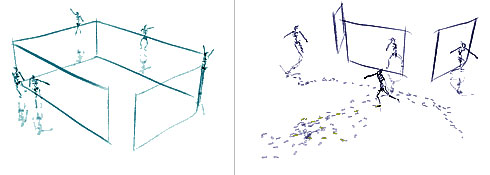
One answer was to put the viewers inside the dance, an ambiguous place on the stage or in the mind. Our first plan inverted the staging of Merce’s magnum opus Ocean (1994), in which he had surrounded his dancers with the audience on all sides of the circular stage. By contrast, we imagined putting the viewers in the center of the dance installation, projecting it on the four walls around them.
Later we shifted to a triptych arrangement, with the central screen flanked at 45 degrees by two smaller ones.
We watched its premiere at the SIGGRAPH conference, where the hand-drawn dancers emerged as incredibly large, twenty-foot sketches, moving precisely through a virtual space even bigger than that framed by the screens. People had to crane their necks and stretch their minds to track the momentarily invisible crossings back and forth between the screens, as sounds of footsteps and breathing – and, at the end, of Ron Kuivila’s deafening electronic music – seemed to move right through them.
A curious thing about Hand-drawn Spaces : The movements we captured were truly detached from the dancers who had so brilliantly performed them, Jeannie Steele and Jared Phillips. The differences between the two in size and sex and style were annulled as Merce combined their captured phrases freely, making long passages in which one dancer’s movements alternated frequently with the other’s, both mapped to the same hand-drawn figure. Psychology and intention were absent from this choreographic process, for Merce used chance operations to see what phrase went next. Here as elsewhere, his art was all about movement, his interest absorbed by how the dancing worked in space and time. He had no qualms about motion-capture or computer composition or hand-drawn rendering, all seen as different means to the same end he’d been pursuing for the past fifty years.
bill t. jones
Not so Bill T. Jones.
“I do not want to be a disembodied, denatured, de-gendered series of lines moving in a void,” he said.
Whereas Hand-drawn Spaces reveled in the freedom of abstracted motion, Ghostcatching would question it.
Of the many ghosts in Ghostcatching , a few have names. Keith Haring is one, for his hand-painting of Jones led to this next collaboration fifteen years later, long after Haring’s death. The famous series of poses, shot by Tseng Kwong Chi, came to our attention when Riverbed was hired by Haring’s estate to translate his work to the computer. This was the prehistory of Ghostcatching .
It had already occurred to me that Haring’s tessellated rooms – covering floor, ceiling, and walls – would make a striking hand-drawn space, a hunch borne out when a colleague modeled them in 3D. On the screen, the tessellation read perfectly flat until the camera moved. Then the planes of the room shifted enough for you to see where wall met floor, and the image snapped into perspective.
Shelley’s initial idea was to animate the Bill T. Jones poses inside the tessellated space. He had already morphed Haring figures into one another, creating an interlocking flux of 2D shapes and identities. Now he wondered whether Bill’s painted body could dance in 3D, twisting in and out of the original poses while the roiling 2D figures – baby, dog, snake, et al – did their own dance on his skin.
It only took a single phone call. Bill came by a week later, looked at early fragments of Hand-drawn Spaces, and said that he knew nothing about computers but was willing to experiment. A stroke of luck put him in San Francisco the same week we were there to motion-capture Merce’s dancers, so we added an early morning session at the Biovision studio and met him there.
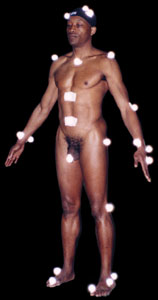
Before we could start, Bill had to have twenty-four markers taped to his body. He looked balefully at these markers, and then at the lights, the cameras, the tripods, the screens – at all the technology of reproduction surrounding him – and said he felt he was breaking a taboo. “Dancers have a strange piety”, he said, “a romantic notion that only the ephemeral moment of performance counts.” To the purist, recording was a blasphemy – like some people not wanting their picture taken for fear of losing their soul. He said we were “ghostcatching,” and the name stuck.
Bill asked how so few markers could possibly capture all his motion. His dancing was not so angular as Merce’s, he explained, not a matter solely of the skeleton and of the angles it took, but also of the undulation and quivering of liquid muscle.
He was right. I had never seen Bill dance before, but now as he started, careful at first with all the markers stuck to him, I saw he was right. He glanced down at the xeroxed photos we’d placed on the floor, and then he improvised sequences connecting one pose to the next. Six times he ran through the series, each improvisation freer and more fluid than the last. As his exuberance took over, the sweat poured out of him and some of the markers popped off of him. Bill’s dance did ripple in waves through his body as his weight kept shifting, and it was true that some of his motion would be near impossible to capture.
Yet afterwards even he could see that the moving dots on the computer screen had caught some sort of essence. “Who am I looking at?” was his first question. Then he said if anyone was to reconstitute his movements in the year 2040, this was how they would do it.
Later, he told us it was like the first time you saw the back of your head in a mirror, and went, “Ah, so that’s what I look like!”
The dots also brought back a Betty Boop cartoon he’d seen as a child.
“Betty goes down to hell, and we watch another character go through fire or an x-ray machine. Afterwards all we see is its skeleton, and Cab Calloway starts singing about ‘Mr. No-body.’
“In other words, there’s no one there, but there is someone there.”
In Bill’s last two improvisations, he’d been seized by the spirit of Haring’s cartoon figures, cutting loose with cartwheels, somersaults, spins, and leaps as if other beings were momentarily spurting through his body, now dancing in complete defiance of the cold concrete floor.
He’d gone far beyond recreating his poses and segues for Haring and the camera.
external eye
The camera was more important to Bill than he had first let on. Quite the contrary, it was central to his practice and had been from the start: his first and most significant partner was a photographer. When Arnie Zane started dancing with him, Zane brought the aesthetic of the frame to their soon-acclaimed duets.
That aesthetic was a preoccupation at SUNY Binghamton, where they studied together in the 70s. A bastion of American experimental filmmaking, the university had Ken Jacobs on its faculty, and frequent screenings by Brakhage, Breer, Frampton, Snow, and Warhol. All stressed the visual and temporal qualities of film, of which the frame – both as a rectangle and as a still picture lasting one twenty-fourth of a second – was the primary element.
Under this influence, Bill and Arnie Zane started making performances “as if in a film editing room.” For a 1983 solo, 21, Bill assigned himself twenty-one postures from art history, pop culture, and religion, improvising a cut-up montage of movement between them (a fragment of which was to resurface in Ghostcatching).
The task he performed for the Haring poses, then and now, was the same. It mirrored the keyframe techniques of film and computer animation (and ballet, for that matter), which also built movement from static positions.
Only long after we started working together did Bill and I discover our common artistic roots in avant-garde film. Here my major debt was to Robert Breer, an animator most famous for making films in which few “shots” were longer than a frame. He disdained traditional keyframe animation, which created a continuous simulation of life through thousands of gradually modified drawings. In that workflow, the key poses are set first, and the smooth “in-betweens” are added later.
Ghostcatching relied on continuous keyframed animation for its fidelity to dance. But there was another aspect of Breer that corresponded closely – his revival of rotoscoping.
In this early method of extracting motion from a figure, the animator traces live action footage frame by frame, so that only certain lines of the moving figure remain. In Breer’s hands, the results were exquisite.

For Gulls and Buoys (1974), he rotoscoped a brief shot of his daughter walking on the seashore. His rough crayon tracings jerked with the imprecision of his hand, but they also moved with the underlying grace of the girl, so that the motions of the artist drawing and of his subject walking seemed to fuse. Since the grain of the crayon wax matched the grain of the film stock, and the rotoscoped waves crumpled in time with the flickering projector, there was a wonderful unity. The image stayed with me ever since.
Breer’s other influence was more accidental. When I came to know Bob, years later, he was a professor at Cooper Union, where he introduced me to his best students. One of them was Shelley, whose eventual hand-drawn animation methods owed nothing, technically, to rotoscoping, yet had much of the same spirit.
The discontinuity of editing was not the only way that film and video influenced Bill. When video recording became affordable, it played a large role in his choreography, as it has in that of nearly all his contemporaries. The video camera runs while Bill improvises new phrases and variations, and afterwards the recording helps him or his rehearsal director to set his motions on his dancers. This means of propagation has obvious parallels to what we had in mind for Ghostcatching.
On Broadway one fall night in the early 80s, I happened upon a riveting breakdance performed by three boys, perhaps eleven years old. Their spasmodic movements traveled from one body to the next like a disease that spread by touch. Soon I made out that it was not a disease but a monster from the movie Alien, the boys vomiting forth the alien baby and enacting the eruption of the monster through the sternum. So precise were their movements that I could almost see the film flickering through them.
This memory came back when I saw the Haring improvisations.
Bill’s movements had come to life, yet they were a mere subset of his full range of dance. Shelley and I wondered what else could emerge from that range. Could it be as tightly defined and with that same sense of otherness?
We speculated with Bill about other beings spinning out from his dance. We called them identities or ghosts or half-lives, and became serious about pinpointing them, scheduling three days in the Houghton Gallery of Cooper Union to do so.
During the Houghton improvisations we singled out classes of movement that we saw in Bill’s dancing, which he then honed and perfected. Shelley made some astute identifications. He had noticed, for example, that Bill sometimes seemed to sculpt his own body into fixed poses, with limbs moving other limbs into position. This observation intrigued Bill, who elaborated on this new “Sculptor” identity in a series of new improvisations that he conceived as a perceptual game between performer and audience:
“The space around the performer must be cleared for the imagination of the viewer to participate in the game. So that you see the performer as almost a two-dimensional construct, and a construct capable of reaching outside the realm of the possible and affecting it even as it reaches outside it, almost like an Escher drawing. It involves muscular and skeletal pushing of the body into shapes or poses in an obvious way. You must see the intent on making shapes for the eye – for an external eye.”
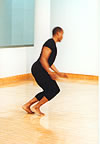
Shelley also identified “Athlete,” whose loud assertive movement was isometric, its force applied against the external forces of gravity and resistance, and “Dog,” whose agile, energetic, horizontal movements reacted to outside stimuli.
Bill imagined the central figure as “a being searching for an acceptable state, trying to perform an impossible task. He is trying on modes of being, knowing that they have to change. This being is full of questions, and sensations that are looking for answers and some sort of release. This is why he moves in space. This is why he changes. He’s full of questions and sensations.
“Because he’s alone,” Bill mused, “he’s crackling with potential. Because the alone is unnatural in the world we inhabit. As viewers, we’re waiting for something to happen where there will be more than one, where he’ll be joined by another.”
Another round of motion-capture, this time in Los Angeles, gave us the dance phrases we needed.
The daylong session was grueling: the floor was again concrete, but this time there were also wires tethering Bill to a much smaller space.
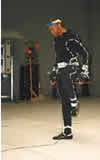
But in between equipment malfunctions he kept breaking free of these restrictions, performing magnificently. He even seized upon weird features of the studio itself, like the trapeze left over from martial arts star Jackie Chan.
Only now do I realize how much of this ambience made its way into Ghostcatching. The wire tethers, the constricted space, the effort to break free – all of it is there.
in the end
In Hand-drawn Spaces, moving figures were all we needed. We cast their reflections on the floor, which became the only visible trace of a world beyond them. The reflections made the footfalls and jumps more palpable; they accentuated the depth of that world, while reasserting the two-dimensionality of the screen. Were they reflections or shadows? In our drawn world they could be either.
In Ghostcatching the visible world also emanates from the dancers, but goes further.
In the beginning we see an ancestral figure enclosed in a tight-fitting box, cycling through a loop of poses. He is made up of the same simple lines and planes as the box, which measures his body’s cubic volume. Does the box hold the dancer in place or does it mark the place the dancer holds to, locked in his keyframed loop? Is it his kinesphere or his coffin?
Elsewhere we see dancers drawing lines in space with their graceful trajectories. When these marks harden and persist, new dancers unravel from the skein, but they too leave their traces, choking the space and capturing the dancers within it.
Moving on, we see a dancer more aware of his reflection. He dances before a mirror, that more ordinary and fleeting means of capture seen in every dance studio. It invites a more natural and intimate partnering.
And at the finale we see multiplied dancers moving as a single complex body. Lines tethering them together seem to propagate phase-shifting motions among them until it all fades out into infinite possibility.
We’ve never left the notions of mental space and drawing as performance. Ghostcatching is more sophisticated than twelve-year-old Mark’s labyrinthine efforts, although it has the same spirit. But Ghostcatching is a different sort of mental space. It arises from several minds all at once. Its meaning lies between us – not only between those of us who made it, but also those who now see it. It’s a collaboration, and it could never have been anything else.
—Paul Kaiser